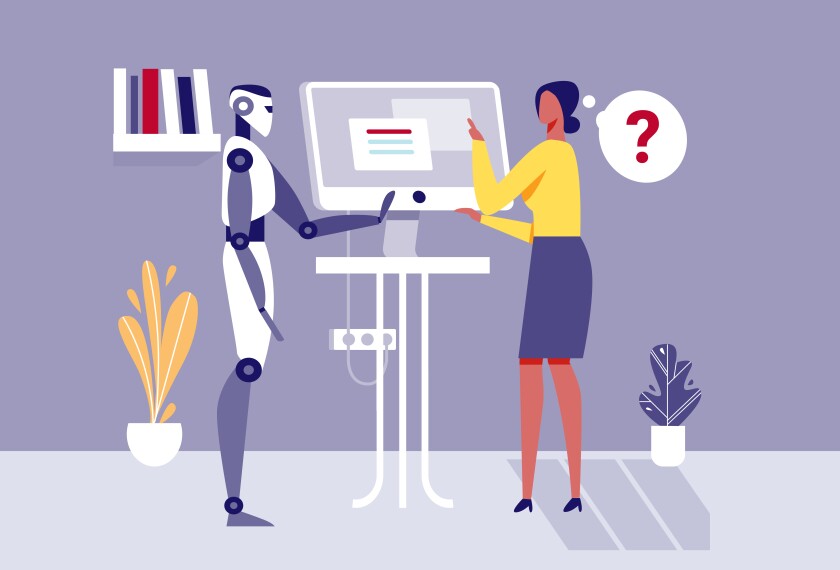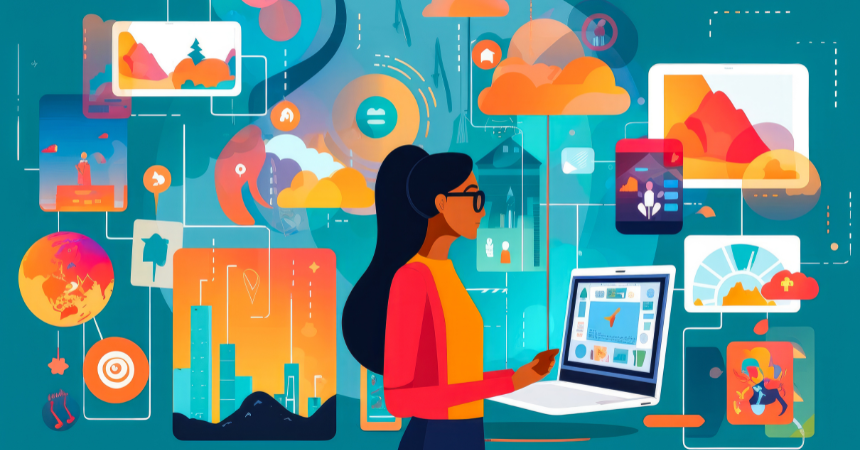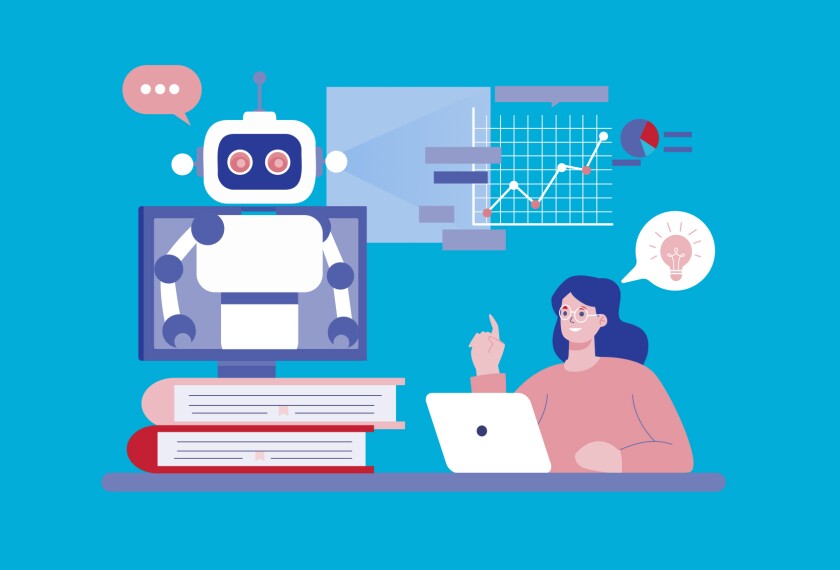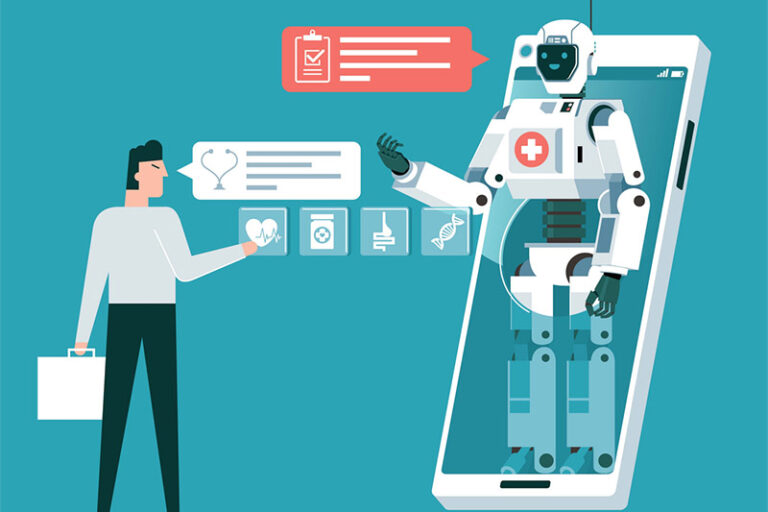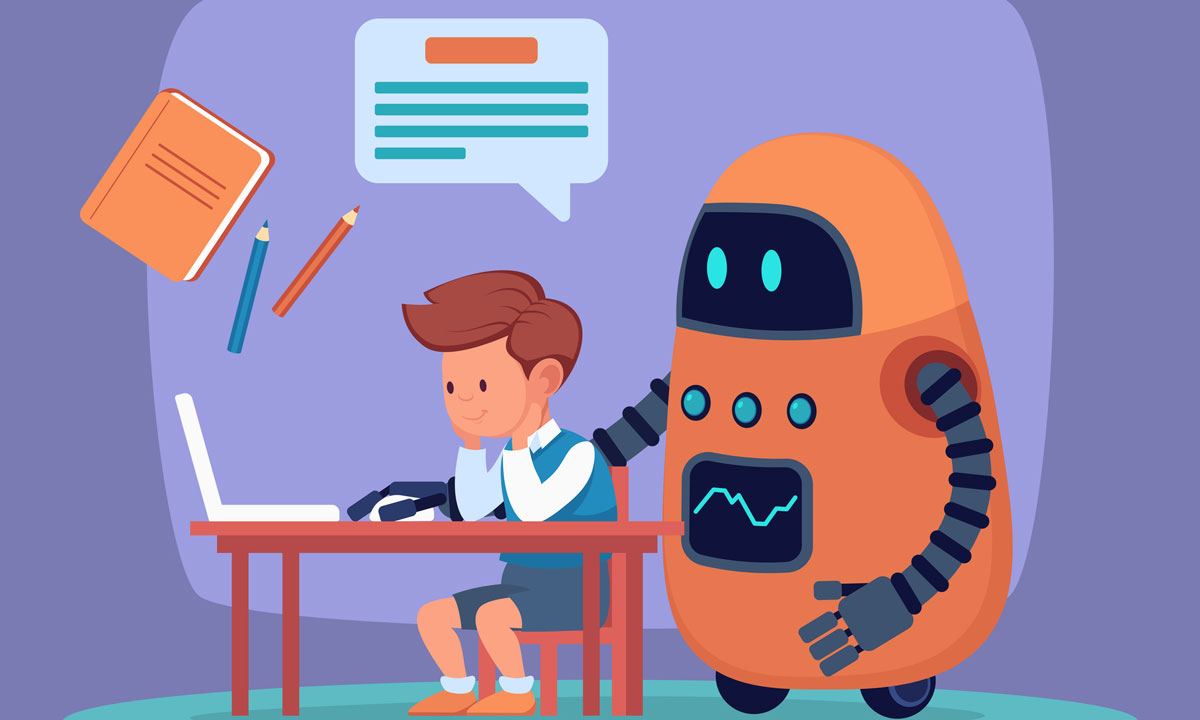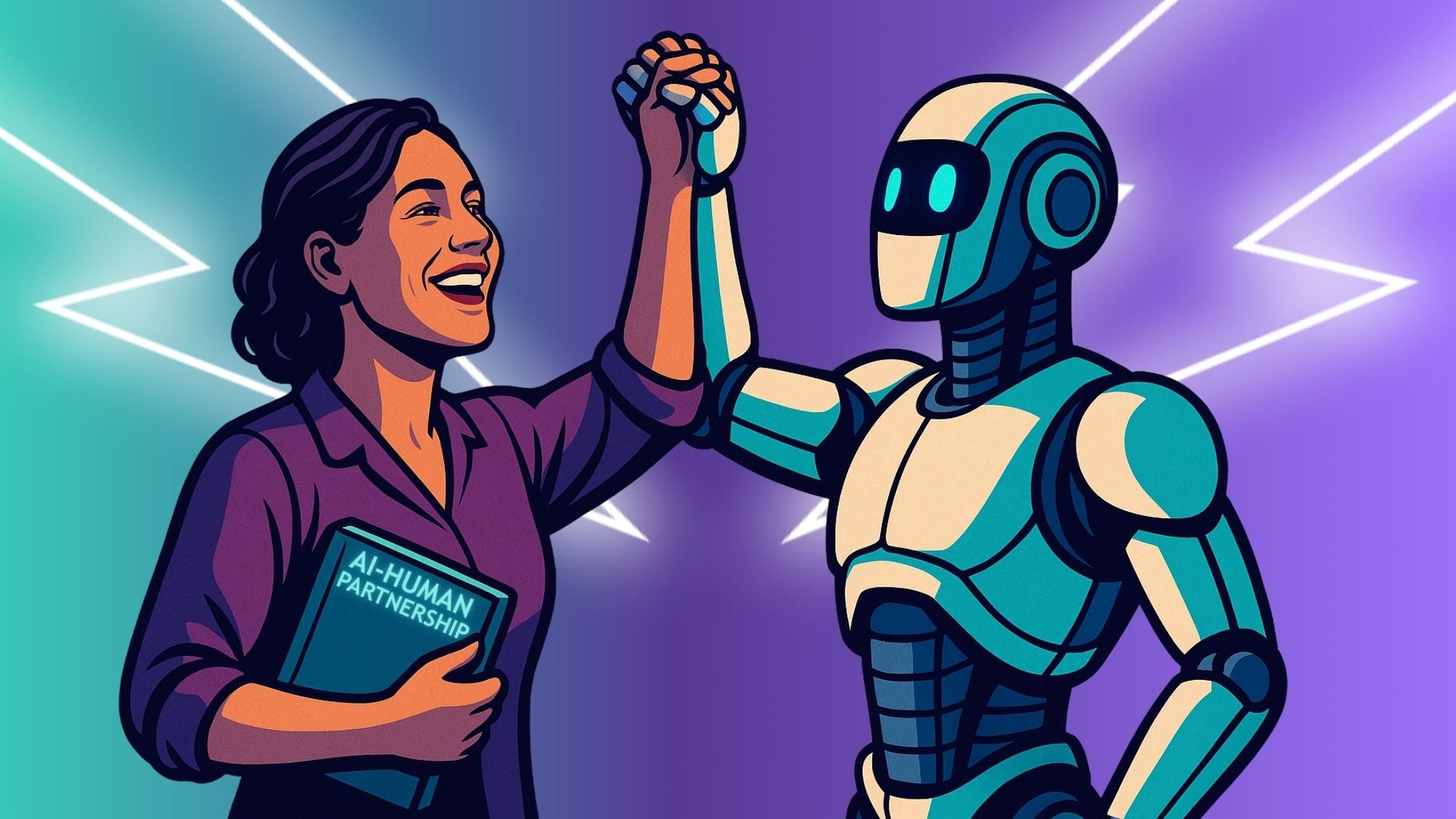Artificial intelligence is transforming education at an unprecedented scale, offering opportunities to personalize learning, enhance inclusion, and empower teachers to focus on empathy, creativity, and ethical guidance. While AI can efficiently handle administrative tasks, adaptive tutoring, and data-driven insights, over-reliance risks eroding critical thinking, emotional development, and professional identity. The future of education lies in human-AI collaboration, where teachers act as orchestrators of learning, co-designing AI tools and guiding students in metacognition, creativity, and moral reasoning. Ethical frameworks, equitable access, and AI literacy are essential to ensure technology amplifies human potential rather than replacing it. By redefining success metrics and prioritizing holistic development, education can harness AI not merely for efficiency, but to cultivate curiosity, compassion, and the uniquely human dimensions of learning.
ಕೃತಕ ಬುದ್ಧಿಮತ್ತೆ (AI) ಅಪ್ರತಿಮ ಪ್ರಮಾಣದಲ್ಲಿ ಶಿಕ್ಷಣವನ್ನು ಪರಿವರ್ತಿಸುತ್ತಿದೆ, ವಿದ್ಯಾರ್ಥಿಗಳ ಕಲಿಕೆಯನ್ನು ವೈಯಕ್ತೀಕರಿಸಲು, ಒಳಗೊಂಡಿಕೆಯನ್ನು ಸುಧಾರಿಸಲು ಮತ್ತು ಶಿಕ್ಷಕರಿಗೆ ಅನುಕಂಪ, ಸೃಜನಶೀಲತೆ ಮತ್ತು ನೈತಿಕ ಮಾರ್ಗದರ್ಶನದ ಮೇಲೆ ಗಮನಹರಿಸಲು ಅವಕಾಶಗಳನ್ನು ನೀಡುತ್ತಿದೆ. AI ಆಡಳಿತಾತ್ಮಕ ಕಾರ್ಯಗಳು, ಅನುಕೂಲವಾದ ಟ್ಯುಟೋರಿಂಗ್ ಮತ್ತು ಡೇಟಾ-ಆಧಾರಿತ ಅಂಕಿಅಂಶಗಳನ್ನು ಪರಿಣಾಮಕಾರಿಯಾಗಿ ನಿರ್ವಹಿಸಬಹುದು, ಆದರೆ ಅದರ ಮೇಲೆ ಹೆಚ್ಚು ಅವಲಂಬನೆ ಮಾನವೀಯ ಚಿಂತನೆ, ಭಾವನಾತ್ಮಕ ವಿಕಾಸ ಮತ್ತು ವೃತ್ತಿಪರ ಗುರುತು ನಾಶವಾಗುವ ಅಪಾಯವನ್ನು ಹುಟ್ಟುಹಾಕುತ್ತದೆ. ಭವಿಷ್ಯದ ಶಿಕ್ಷಣವು ಮಾನವ–AI ಸಹಕಾರದಲ್ಲಿ নিহಿತವಾಗಿದ್ದು, ಶಿಕ್ಷಕರು ಕಲಿಕೆಯ ನಿರ್ವಾಹಕರು ಆಗಿ, AI ಉಪಕರಣಗಳನ್ನು ಸಹ-ರಚನೆ ಮಾಡುತ್ತಾ ಮತ್ತು ವಿದ್ಯಾರ್ಥಿಗಳನ್ನು ಮೆಟಾಕಾಗ್ನಿಷನ್, ಸೃಜನಶೀಲತೆ ಮತ್ತು ನೈತಿಕ ತೀರ್ಮಾನಗಳಲ್ಲಿ ಮಾರ್ಗದರ್ಶಿಸುತ್ತಾರೆ. ನೈತಿಕ ಸಂರಚನೆಗಳು, ಸಮಾನ ಪ್ರವೇಶ ಮತ್ತು AI ಸಾಮರ್ಥ್ಯತೆ ಅತ್ಯಾವಶ್ಯಕವಾಗಿವೆ, ತಂತ್ರಜ್ಞಾನವು ಮಾನವ ಸಾಮರ್ಥ್ಯವನ್ನು ಹೆಚ್ಚಿಸುವಂತೆ ಮಾಡಲು, ಬದಲಾಗಿ ಅದನ್ನು ಪ್ರತಿಸ್ಥಾಪಿಸುವುದಿಲ್ಲ. ಯಶಸ್ಸಿನ ಅಳೆಯುವ ಮಾನದಂಡಗಳನ್ನು ಪುನರ್ವ್ಯಾಖ್ಯಾನಿಸಿ, ಸಮಗ್ರ ಅಭಿವೃದ್ಧಿಯನ್ನು ಪ್ರಧಾನ ಮಾಡುವ ಮೂಲಕ, ಶಿಕ್ಷಣವು ಕೇವಲ ಕಾರ್ಯಕ್ಷಮತೆಯಿಗಾಗಿ ಅಲ್ಲ, ಕುತೂಹಲ, ಸಹಾನುಭೂತಿ ಮತ್ತು ಕಲಿಕೆಯ ವಿಶಿಷ್ಟ ಮಾನವೀಯ ಆಯಾಮಗಳನ್ನು ಬೆಳೆಸಲು AI ಅನ್ನು ಉಪಯೋಗಿಸಬಹುದು.
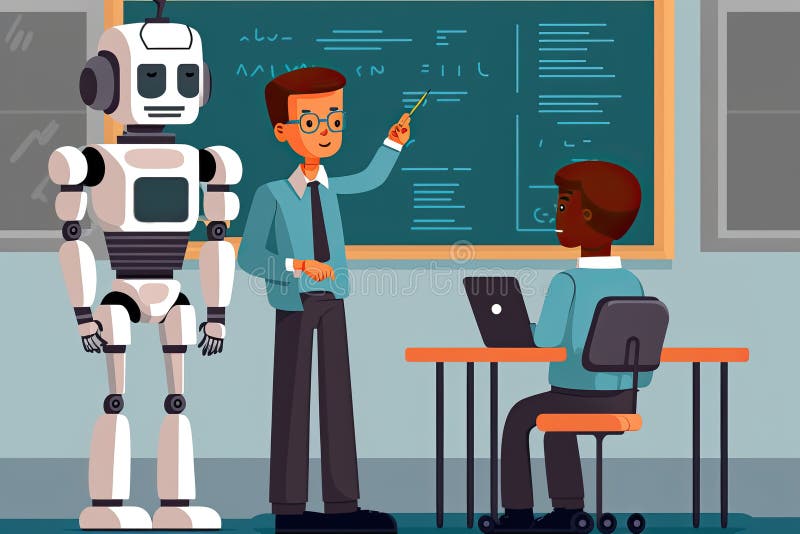
AI and Teachers – Trends, Opportunities, and Challenges: Building Human-Centered Education in the Age of Intelligent Machines
Intended Audience and Purpose
This article is written for educators, policymakers, education technology leaders, social entrepreneurs, and academic researchers—those who stand at the frontier of a transformation that is both exhilarating and unsettling: the rise of Artificial Intelligence in education.
It seeks to engage those who understand that education is not merely the transfer of knowledge but the cultivation of wisdom, and that the introduction of intelligent machines into this sacred process must be approached with both enthusiasm and reverence. This is not a technical brief on machine learning models or neural networks; it is a human conversation about the redefinition of learning, teaching, and purpose in an age where intelligence itself is being re-engineered.
Purpose and Direction
- To critically analyze how AI is transforming teaching and learning ecosystems.
The article examines the vast influence of AI on the educational continuum—from curriculum design and classroom management to assessment, pedagogy, and teacher identity. It explores how algorithms now track cognitive patterns, predict learning outcomes, and even attempt to simulate empathy, all while reshaping the role of human educators. But the analysis will go beyond technological trends; it will probe the psychological, philosophical, and ethical undercurrents that accompany this transformation. - To balance optimism with caution by highlighting both the promises and the perils of AI in education.
While AI offers precision, personalization, and accessibility unparalleled in history, it also threatens to erode the deeper dimensions of learning—curiosity, moral reflection, and human connection. The article will invite readers to question: Can efficiency and empathy coexist? Can we automate education without mechanizing the mind? It will contrast the visionary optimism of AI advocates like Wayne Holmes and Anthony Seldon with the sober ethical reminders of UNESCO’s policy frameworks, revealing that the future of learning is not about replacing teachers but about redefining what it means to teach and to learn. - To offer a roadmap toward ethical, inclusive, and human-centered AI integration, ensuring that teachers remain indispensable architects of the learning experience.
The goal is not to romanticize human teaching nor to vilify AI, but to integrate the two through thoughtful design, ethical governance, and compassionate leadership. Drawing from works such as The Fourth Education Revolution and Education and AI: The Future of Learning, the article envisions a balanced future—one where technology liberates teachers from mechanical tasks, allowing them to focus on what no machine can emulate: the art of understanding, inspiring, and transforming human lives.
I. Introduction: The Fourth Education Revolution Has Begun
1.1 The Context: From Industrial to Intelligent Education Systems
We are entering what Sir Anthony Seldon calls The Fourth Education Revolution—a transformation that transcends previous technological shifts in both scale and depth. The first revolution was sparked by the printing press, democratizing access to knowledge. The second emerged through mass education, institutionalizing learning as a public good. The third, the digital revolution, expanded learning spaces through computers and the internet.
But the Fourth Revolution, powered by Artificial Intelligence (AI), is fundamentally different. It does not merely change how education is delivered; it changes what it means to learn, to know, and to teach. AI introduces systems that do not just transmit information but interpret, predict, and adapt—reshaping human cognition itself. Learning is no longer bound by classrooms, textbooks, or even curricula; it becomes intelligent, adaptive, and continuous.
As Rose Luckin notes in Education and AI: The Future of Learning, this new era redefines intelligence as an interplay between human and artificial capacities. The traditional teacher-centered model gives way to dynamic ecosystems where learners, data, and intelligent tools co-create knowledge. Yet this shift also forces us to confront an unsettling truth: when machines can mimic understanding, how do we preserve what makes learning profoundly human?
1.2 The Promise and the Paradox
The promise of AI in education is dazzling. It can personalize learning at an unprecedented scale—tailoring instruction to each learner’s pace, preferences, and progress. It can automate administrative burdens, freeing teachers to focus on mentorship and creativity. It can identify learning gaps, offer multilingual support, and bring quality education to underserved populations.
But this promise carries a profound paradox. If machines can teach, what becomes of the teacher? Does AI democratize education or dehumanize it?
Wayne Holmes, Maya Bialik, and Charles Fadel, in Artificial Intelligence in Education: Promises and Implications for Teaching and Learning, argue that the debate must evolve from “Can AI replace teachers?” to the more essential question: “How can AI empower teachers and enrich learning?” Their research reminds us that while algorithms can process patterns, only humans can nurture purpose. AI may enhance instruction, but only educators can cultivate wisdom.
UNESCO’s Ethics of Artificial Intelligence and Education policy paper echoes this caution, urging societies to ensure that AI “serves as a tool for human flourishing, not a substitute for human judgment.” The integration of AI into education, therefore, is not merely a technical challenge—it is a moral and philosophical one.
1.3 Thesis Statement
AI will not replace teachers, but teachers who leverage AI will redefine education.
The future belongs to augmented teachers—educators who harness the computational precision of AI without surrendering the emotional depth and ethical discernment that make education transformative. These teachers will act as learning architects, guiding students through a landscape of infinite information toward genuine understanding and character formation.
In this Fourth Education Revolution, the role of the teacher is not diminished—it is amplified. The most powerful classrooms of tomorrow will not be run by machines but by humans empowered by intelligent tools, weaving empathy and ethics into the algorithmic fabric of education.
II. The Current Landscape: AI in Today’s Classrooms
2.1 Personalized and Adaptive Learning Systems (Holmes et al., 2019)
The most visible face of AI in education today is personalization. No two learners are identical—and for the first time in history, technology is beginning to act on that truth. AI-driven platforms analyze performance data, learning patterns, and even emotional cues to tailor content, pacing, and pedagogy for each student.
As Wayne Holmes, Maya Bialik, and Charles Fadel emphasize in Artificial Intelligence in Education: Promises and Implications for Teaching and Learning, this move from standardization to individuation represents a seismic shift. Tools such as DreamBox Learning, Knewton, and Century Tech employ machine learning and reinforcement algorithms to adapt lessons in real time—adjusting difficulty, sequencing, and feedback based on continuous learner interaction.
The result is an ecosystem where students are not passive recipients of instruction but active participants in a personalized learning journey. Engagement rises, retention improves, and students often experience a renewed sense of ownership over their education.
However, personalization comes with a caveat: data dependency. Every adaptive insight relies on streams of learner data—raising concerns about privacy, surveillance, and algorithmic bias. The question becomes not only what AI can teach, but what it learns about us while doing so.
2.2 Administrative Automation and Teacher Assistance (Luckin, 2018)
While much attention focuses on how AI transforms student learning, an equally profound change is occurring behind the scenes: AI is reshaping the teacher’s workflow. Administrative overload—grading, attendance tracking, report generation—has long drained teachers of time and energy that could be spent on mentorship, creativity, and care.
AI systems are now automating many of these tasks. Automated essay scoring, predictive analytics for student performance, and smart scheduling systems have begun to liberate teachers from bureaucratic routine, enabling them to refocus on the human dimensions of teaching.
Rose Luckin, in Education and AI: The Future of Learning, captures this shift through her concept of “AI as a Mirror.” Rather than replacing educators, AI should reflect back insights about learners’ cognitive and emotional processes, helping teachers see more clearly what was once invisible—such as how students think, struggle, and grow.
This mirror function redefines teacher agency. Instead of being displaced by technology, teachers become data-informed mentors who can diagnose learning difficulties with greater empathy and precision. Yet this also requires new skills—what Luckin calls “AI literacy for educators”—so teachers can interpret data critically rather than defer blindly to algorithmic authority.
2.3 AI-Enhanced Tutoring and Learning Companions
Beyond the classroom, AI has quietly birthed a new species of educator: the digital learning companion. Tools like Khanmigo (from Khan Academy), Duolingo Max, and Socratic by Google now provide 24/7 personalized tutoring and feedback. These systems are powered by natural language processing models that engage learners in conversational problem-solving—explaining concepts, providing examples, and offering hints at the right moment.
AI excels particularly in drill-based and mastery learning, where iterative feedback loops strengthen understanding in subjects like mathematics, programming, and language acquisition. The scalability of such systems is unmatched—millions of students can receive individualized tutoring simultaneously, something no traditional model could sustain.
However, these companions still lack contextual sensitivity. They can guide a learner through how to solve a problem, but they rarely understand why the learner struggles, or how emotion, motivation, and self-worth intersect with cognition. Here lies the irreplaceable domain of the human teacher—the capacity to discern meaning beyond metrics.
2.4 Immersive and Intelligent Learning Environments
The convergence of AI, Augmented Reality (AR), Virtual Reality (VR), and gamification is creating a new frontier of immersive education. These technologies blend experiential and cognitive learning, transforming abstract concepts into tangible experiences. Imagine a history student walking through an AI-guided simulation of ancient civilizations, or a medical trainee performing virtual surgeries with real-time adaptive feedback.
AI serves as the intelligent engine behind these environments—tracking learner responses, adjusting scenarios dynamically, and assessing competence through behavior rather than static tests. Adaptive simulations are now used in engineering, medicine, and even ethics education, allowing students to learn through guided exploration rather than rote memorization.
These environments also nurture the joy of discovery, something often lost in traditional classrooms. Yet they raise deeper pedagogical questions: Will immersive AI-based learning amplify critical thinking, or will it turn learning into entertainment? Can we simulate wisdom as easily as we simulate worlds?
As UNESCO’s policy paper Ethics of Artificial Intelligence and Education reminds us, the adoption of these technologies must be guided by ethical frameworks that safeguard human dignity, promote equity, and preserve the moral imagination of learners. AI may create the classroom of the future—but it is humanity’s responsibility to ensure it remains a place of meaning, not merely stimulation.
III. The Promises and Opportunities of AI in Education
The rise of Artificial Intelligence in education offers extraordinary opportunities—perhaps the most significant in centuries—to reimagine learning as more inclusive, adaptive, and human-centered than ever before. Far from a dystopian replacement of teachers, AI—when ethically and intelligently deployed—can amplify the potential of both learners and educators. Yet, realizing these promises requires discernment: knowing where AI adds value, and where the human touch remains irreplaceable.
3.1 Personalization and Inclusion (Holmes et al., Luckin)
One of AI’s greatest promises lies in personalized learning—the ability to meet each learner where they are, rather than forcing all to move at the same pace. AI systems can now analyze vast amounts of data—from quiz results and eye-tracking patterns to keystrokes and voice inflection—to model each learner’s unique cognitive profile.
Wayne Holmes, Maya Bialik, and Charles Fadel describe this as a shift from mass education to micro education—learning that is not only differentiated but dynamically evolving. Rose Luckin expands on this by suggesting that AI can help teachers understand “how learners learn,” revealing hidden patterns of cognition that would otherwise remain invisible.
Beyond personalization, AI technologies are driving inclusion. Tools such as speech-to-text, predictive typing, AI-powered reading aids, and sign language recognition are transforming accessibility for learners with disabilities. These assistive technologies, guided by principles of universal design for learning, are creating educational environments where physical, linguistic, and cognitive barriers are gradually dismantled.
In this way, AI becomes not just a tutor—but a translator of human potential, bridging diversity in ability, language, and learning style.
3.2 Pedagogical Enhancement and Evidence-Based Decision Making
AI also empowers teachers to make evidence-based pedagogical decisions. Instead of relying solely on intuition or summative exams, educators can access deep insights into learner engagement, misconceptions, and progress.
Machine learning models can analyze learning trajectories to predict when a student is likely to struggle, allowing real-time interventions before failure occurs. Teachers, in turn, can adapt instruction with precision—targeting not just what students got wrong, but why.
This shift from reactive to proactive pedagogy transforms the classroom into a living laboratory of continuous improvement. Teachers become reflective practitioners, supported by intelligent analytics that illuminate hidden dynamics of learning—cognitive fatigue, motivational dips, or social isolation.
However, as Holmes et al. remind us, data must serve understanding, not control. The power of analytics must always be guided by ethical intent—to inform empathy, not surveillance.
3.3 Efficiency and Scalability (Seldon & Abidoye)
For the first time in history, AI offers the possibility of scaling quality education globally. In many regions, particularly across the Global South, chronic teacher shortages and uneven resource distribution have limited access to quality instruction.
Anthony Seldon and Oladimeji Abidoye, in The Fourth Education Revolution, argue that AI tutors could democratize access by offering consistent, high-quality learning experiences to millions simultaneously. Systems such as Squirrel AI, Khanmigo, and Byju’s AI Mentor exemplify this scalability—providing instant feedback, adaptive pacing, and contextual learning across diverse languages and subjects.
Such scalability does not imply homogenization; rather, it can amplify diversity, bringing localized content to global learners. When properly contextualized, AI can help bridge the educational divide between urban and rural, privileged and marginalized, teacher-rich and teacher-scarce contexts.
Yet Seldon and Abidoye caution that technology alone cannot replace the moral and emotional presence of a human guide. The true revolution, they argue, will come not from machines teaching humans—but from humans using machines to liberate education from its industrial constraints.
3.4 Rethinking the Role of the Teacher
AI’s greatest gift to education may be the redefinition of the teacher’s role. Freed from administrative drudgery and mechanical grading, teachers can return to their original vocation: the cultivation of human potential.
Anthony Seldon envisions the AI-empowered teacher as an orchestrator of human flourishing. In this new paradigm, teachers shift from content transmitters to learning designers, mentors, and ethical leaders. They guide emotional, moral, and social learning—domains where algorithms falter.
AI thus becomes the teacher’s silent collaborator—handling routine cognitive tasks while the human educator focuses on relational and creative dimensions. Imagine a world where teachers spend their time not filling report cards, but inspiring curiosity, empathy, and courage.
This transformation demands new skills: data literacy, ethical reasoning, and technological fluency. But more importantly, it requires a renewal of purpose—teachers as custodians of meaning in an age of machines.
3.5 Democratizing Knowledge and Reducing Bias in Assessment
Finally, AI holds the potential to make assessment more transparent and fair—if designed with ethical integrity. Algorithms can grade consistently across vast cohorts, eliminating human fatigue, favoritism, and unconscious bias. When calibrated carefully, they can provide feedback based on performance evidence, not subjective impressions.
AI can also enable continuous and formative assessment, replacing the high-stakes testing culture with ongoing dialogue about growth. Learners can track progress dynamically, and teachers can intervene constructively—turning assessment into learning, not judgment.
However, as UNESCO’s Ethics of Artificial Intelligence and Education warns, this promise depends entirely on how systems are designed and governed. Biased datasets, opaque algorithms, and cultural blindness can reproduce the very inequities AI seeks to overcome.
Hence, democratizing knowledge through AI requires algorithmic transparency, human oversight, and cultural humility. Only then can AI serve as an instrument of justice rather than power.
In sum, the promise of AI in education lies not in replacing teachers or mechanizing learning, but in elevating human purpose. When aligned with ethical design, empathetic pedagogy, and inclusive governance, AI can fulfill its highest calling: to expand what it means to be human in the pursuit of knowledge.
IV. The Challenges, Risks, and Ethical Dilemmas
Every revolution brings both liberation and loss. The Fourth Education Revolution—driven by Artificial Intelligence—promises unprecedented access, personalization, and insight, but it also raises profound ethical, emotional, and existential questions. As with any powerful technology, its value depends not on what it can do, but on how consciously and compassionately it is used.
While AI holds the potential to elevate human learning, it also threatens to erode the very qualities that make education a moral and human enterprise. Drawing upon the warnings of Holmes et al., Luckin, Seldon & Abidoye, and UNESCO’s AI Ethics Policy Papers, this section examines the risks that accompany the AI revolution in education.
4.1 Functional Risks (Holmes et al.)
Wayne Holmes and colleagues caution that an over-dependence on AI may inadvertently weaken human cognition, creativity, and critical reasoning—the very faculties education is meant to strengthen.
When AI automates tasks like essay writing, problem-solving, or even idea generation, students risk becoming consumers of insight rather than creators of it. Learning could devolve into performance optimization, where students chase algorithmic approval instead of genuine understanding. The joy of struggle—the cognitive friction that forges mastery—could be lost.
Holmes et al. call this a shift from learning for wisdom to learning for efficiency. As AI becomes more sophisticated in predicting student needs, it might also dull the learner’s metacognitive agency—their ability to think about their own thinking. Education could become frictionless, but also soulless.
The challenge, then, is to ensure that AI systems are designed to amplify curiosity, not replace it; to enhance creativity, not automate it.
4.2 Emotional and Social Risks (Luckin)
Rose Luckin warns that while AI can mirror certain cognitive aspects of teaching, it remains profoundly limited in its ability to replicate emotional and relational intelligence. Teachers are not just conveyors of information; they are emotional architects who cultivate empathy, resilience, and moral character in students.
The risk is that in our pursuit of efficiency, classrooms may become transactional learning environments, optimized for measurable outcomes but devoid of human connection. The loss of what Luckin calls “relational learning”—the shared emotional context between teacher and student—could dehumanize education, turning learning into a data-driven transaction rather than a transformative journey.
Children, especially, learn through attunement—by observing, imitating, and emotionally synchronizing with trusted adults. AI may simulate encouragement or empathy, but it cannot feel them. Without real human presence, education risks producing students who are technically competent yet emotionally undernourished.
The antidote, Luckin insists, is to design AI not as a replacement, but as a mirror—a reflective tool that helps teachers see more deeply into the learning process without losing their humanity in the process.
4.3 Employment and Identity Crisis (Seldon & Abidoye)
For teachers, AI introduces not just technical challenges, but an existential one: Who am I, if a machine can do what I do?
Anthony Seldon and Oladimeji Abidoye warn that unless teachers are proactively retrained and re-envisioned as AI collaborators, the profession risks a “de-professionalization of teaching.” Educators could be reduced to system operators, managing algorithms rather than mentoring minds.
This identity crisis breeds fear and resistance. Many teachers worry that automation will erode the dignity of their profession or render their expertise obsolete. Yet, Seldon and Abidoye argue that the opposite can be true—if educators embrace their evolving role as orchestrators of human flourishing.
The future of teaching, therefore, depends on courageous adaptation: learning to use AI as a partner in creativity, not a competitor. But this transformation requires systemic support—policy frameworks, retraining programs, and institutional cultures that value human insight as irreplaceable.
4.4 Information, Privacy, and Data Ethics (UNESCO Policy Papers)
Perhaps the most pressing challenge in AI-driven education lies in data ethics—who owns, controls, and benefits from the vast amount of student data collected.
AI systems depend on continuous streams of personal information—learning patterns, emotional responses, and even biometric data. Without strong ethical safeguards, this data can be exploited for commercial, political, or manipulative purposes. UNESCO’s Policy Papers on the Ethics of Artificial Intelligence in Education call attention to this growing danger, advocating for:
- Transparency: Algorithms must be explainable and open to scrutiny.
- Data Minimization: Only the essential data for learning improvement should be collected.
- Informed Consent: Students, parents, and educators must understand how their data is used.
- Human Oversight Principle: All AI-driven decisions in education must remain accountable to human educators and institutions.
The darker side of educational AI is surveillance capitalism—where learning data becomes a commodity. If unchecked, this can erode trust, autonomy, and even the psychological safety of learners. The moral imperative, therefore, is clear: AI in education must be designed to serve learners, not to monetize them.
4.5 The Digital Divide and AI Literacy Gap
Despite the rhetoric of democratization, AI may paradoxically widen the gap between the privileged and the marginalized. Access to AI-powered education depends on reliable infrastructure, hardware, and connectivity—luxuries still unavailable in many parts of the world.
This creates a two-tiered education system: one where students in affluent regions learn through adaptive, data-driven tools, while others are left behind in analog classrooms. The same applies to teachers. Without targeted investment in AI literacy and professional development, educators in under-resourced regions risk becoming obsolete in an increasingly digital ecosystem.
UNESCO and the World Bank have repeatedly warned that technological inclusion must precede technological innovation. If we fail to address these structural inequalities, AI may deepen the very injustices education was meant to correct.
The challenge, then, is not simply to integrate AI into education, but to democratize access to it—ensuring that every learner, regardless of geography or income, can benefit from this revolution.
In summary, while AI promises to enhance learning and empower teachers, it also threatens to fragment the educational landscape, compromise privacy, and weaken human agency. The ultimate question is not what AI can do for education, but what kind of education we want AI to serve.
V. Toward Human–AI Collaboration: Redefining the Teacher’s Role
The real promise of AI in education does not lie in automation or substitution—it lies in collaboration. As machines become more capable, the role of teachers must evolve from information providers to architects of learning experience and guardians of meaning. This section explores the emerging frameworks and philosophical shifts shaping this new pedagogy.
5.1 The “Centaur Model” of Education (Luckin)
- The Centaur Model, inspired by the synergy between human intuition and machine intelligence in competitive chess, represents a pragmatic vision for education’s future.
- Human-AI hybrids—where the teacher’s empathy, contextual judgment, and moral reasoning complement AI’s data-driven precision—create richer, more responsive learning ecosystems.
- In this model, teachers become learning strategists: they orchestrate content sequencing, emotional tone, and creative engagement, while AI manages analytics, feedback loops, and personalized scaffolding.
- Luckin’s central insight—AI as a Mirror—reminds us that technology should reflect human cognition, not replace it. AI’s value lies in helping teachers “see learning” more clearly, identifying invisible struggles and cognitive blind spots.
5.2 The New Pedagogical Paradigm
- The teacher’s identity must evolve from content expert to metacognitive mentor.
- The future classroom is less about knowledge transmission and more about meta-learning—the capacity to learn how to learn.
- Holmes and colleagues emphasize fostering metacognition, curiosity, and creativity, the uniquely human faculties that transcend algorithmic replication.
- AI systems can deliver information efficiently, but meaning-making remains a deeply human act—born from dialogue, reflection, and shared moral imagination.
- Hence, pedagogy must pivot from “coverage” to cultivation—nurturing minds capable of navigating uncertainty and designing original pathways of inquiry.
5.3 Teacher Training and AI Literacy (UNESCO, Holmes)
- The integration of AI into classrooms demands systematic re-skilling and up-skilling of educators.
- UNESCO advocates for teacher agency—teachers should be co-designers and critical evaluators of AI tools, not mere end-users.
- Professional development programs should interweave AI literacy with ethical awareness, ensuring teachers understand how algorithms work, where biases lurk, and how to safeguard student data.
- A teacher’s digital competence now includes interpreting algorithmic feedback, curating AI-generated content, and maintaining emotional authenticity amid technological mediation.
- This new professionalism reclaims dignity for educators by positioning them as ethical stewards of human learning in a machine-augmented age.
5.4 Ethical and Policy Frameworks
- The AI revolution in education requires clear moral and legal boundaries. Governments and educational bodies must establish AI-in-Education Ethics Codes encompassing:
- Data Privacy and Ownership: Students’ data should be treated as a human right, not a commodity.
- Algorithmic Transparency: Stakeholders must understand how AI makes decisions and what data it uses.
- Equity and Inclusion: Policies should ensure that AI does not reinforce systemic inequalities.
- UNESCO further encourages open-source, community-driven educational AI to prevent dependence on corporate monopolies and preserve public trust.
- Ethical governance of AI in education is not a bureaucratic afterthought—it is the moral infrastructure that ensures technology serves the soul of education, not its shadow.
Human–AI collaboration marks the next great pedagogical evolution. Teachers, not algorithms, will remain the moral compass of learning—guiding curiosity, shaping empathy, and anchoring wisdom. The challenge ahead is not to resist technology, but to redefine humanity’s role within it.
VI. The Future Vision: Ethical, Inclusive, and Human-Centered AI Education
As the digital age matures, education must rediscover its soul. The goal is not to mechanize learning, but to humanize technology. The future of AI in education must move beyond the binary of optimism and fear, toward a balanced vision rooted in ethics, empathy, and equity. In this reimagined paradigm, AI becomes not the master of minds, but the mirror of meaning—reflecting our highest human aspirations.
6.1 The Principle of “Augmented Humanity” (Seldon & Luckin)
- The defining principle of 21st-century education must be Augmented Humanity, a term articulated by Seldon and Luckin to describe the synergy between human values and technological capability.
- The mission of AI in learning should be amplification, not automation—enriching human potential rather than replacing it.
- True progress lies not in creating faster learners or more efficient schools, but in nurturing conscience, creativity, and compassion—qualities that machines can simulate but never embody.
- Education, in this light, becomes an act of collective self-evolution—where AI serves as the catalyst for deeper wisdom, not just higher performance.
- As Seldon writes, “AI will not make us more human unless we choose to be.” Thus, the challenge is moral before it is technological.
6.2 AI for Equity and Empowerment
- If governed wisely, AI can become the great equalizer in global education—bridging divides of geography, privilege, and ability.
- Adaptive learning platforms can empower underprivileged students, remote learners, and neurodiverse individuals with personalized pathways once unimaginable.
- For learners with autism or cognitive differences, AI-driven assistive technologies—such as emotion recognition, multimodal feedback, and visual storytelling—can unlock communication and creativity.
- Here, NGOs like the MEDA Foundation stand at the forefront. By integrating AI literacy into inclusive education programs, MEDA can create ecosystems where every learner—irrespective of background or neurotype—discovers their potential and earns meaningful livelihoods.
- This vision demands not just technology, but community orchestration: collaboration between governments, educators, technologists, and social entrepreneurs to make AI a tool for empowerment rather than exclusion.
6.3 Rethinking Success Metrics in the Age of AI
- The rise of AI challenges one of the deepest assumptions in modern schooling—that learning can be measured through standardized testing and rote efficiency.
- As automation expands, human value will increasingly lie in what machines cannot replicate: creativity, empathy, moral judgment, and collective intelligence.
- Future education systems must therefore redefine success in terms of adaptability, collaborative problem-solving, and ethical awareness.
- Holmes and UNESCO both argue that the next generation of assessment should evaluate not what students remember, but how they relate, imagine, and reason.
- In essence, education must measure what makes us human—not what makes us efficient.
The future of AI in education is not a technological revolution—it is a spiritual and civilizational one. It calls us to design systems where knowledge serves wisdom, and intelligence serves compassion. The measure of progress will not be the sophistication of algorithms, but the elevation of the human spirit they enable.
VII. Conclusion: Wisdom in the Age of Algorithms
The story of education has always been the story of humanity itself—how we learn, teach, remember, and aspire. Today, as artificial intelligence reshapes the contours of learning, we stand at a profound threshold. The question is no longer what AI can do for education, but what kind of education will shape the AI-driven world.
7.1 The Final Balance
The greatest danger of artificial intelligence is not that it will outthink us—but that we will stop thinking for ourselves.
AI’s ascent tempts us toward convenience over contemplation, efficiency over empathy, data over discernment. Yet, these are precisely the moments when wisdom must lead innovation.
Education in the age of algorithms must therefore do more than transmit information—it must awaken consciousness. As Holmes reminds us, intelligence without wisdom is directionless; knowledge without ethics is perilous.
AI’s rise is thus an invitation—a call to reclaim what only humans can provide: empathy, ethics, and emotional depth. These are not peripheral virtues; they are the very essence of what it means to be educated.
7.2 The Path Forward
The way ahead is not rejection or blind acceptance of AI, but co-evolution—a deliberate partnership between human insight and machine intelligence. To navigate this future wisely, three imperatives must guide our journey:
- Empower teachers as ethical leaders of transformation.
Teachers are not relics of the pre-digital era; they are architects of humanity’s next chapter. Their emotional intelligence and moral judgment remain irreplaceable pillars of learning. - Develop “AI literacy for humanity,” not just technical competence.
Students must learn not only how to use AI tools but also how to question them—cultivating critical thinking, digital ethics, and cross-cultural empathy. - Foster ecosystems where AI and teachers co-evolve for holistic human development.
This requires collaboration among governments, schools, NGOs, and technologists to ensure that every learner—regardless of background—benefits from inclusive, human-centered innovation.
Ultimately, the fusion of AI and education must serve a single moral compass: to make us more human, not less.
Participate and Donate to MEDA Foundation
Join MEDA Foundation in advancing AI literacy, teacher empowerment, and inclusive education across India.
Your support helps create self-sustaining ecosystems where technology and humanity coexist harmoniously—where every learner, including those on the autism spectrum or in underserved regions, can thrive in the AI era.
Together, we can shape an education system that celebrates both intelligence and integrity, both innovation and inclusion.
Book References and Recommended Readings
- Holmes, W., Bialik, M., & Fadel, C. (2019). Artificial Intelligence in Education: Promises and Implications for Teaching and Learning. Center for Curriculum Redesign.
- Seldon, A., & Abidoye, O. (2018). The Fourth Education Revolution: Will Artificial Intelligence Liberate or Infantilise Humanity? University of Buckingham Press.
- Luckin, R. (2018). Education and AI: The Future of Learning.
- UNESCO (2021). Ethics of Artificial Intelligence and Education: Policy Guidance Papers.
- Daugherty, P., & Wilson, H. (2018). Human + Machine: Reimagining Work in the Age of AI. Harvard Business Review Press.
- Lee, K.-F. (2021). AI 2041: Ten Visions for Our Future.

